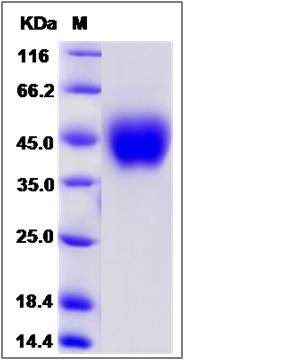Mouse FCRL1 / FCRH1 Protein (His Tag)
A230020G22Rik,Bxmas1,Bxmh1,Bxmh1b,Fcrh1,Fcrh1l,Fcrh1s,Ifgp1
- 100ug (NPP3312) Please inquiry
| Catalog Number | P50947-M08H |
|---|---|
| Organism Species | Mouse |
| Host | Human Cells |
| Synonyms | A230020G22Rik,Bxmas1,Bxmh1,Bxmh1b,Fcrh1,Fcrh1l,Fcrh1s,Ifgp1 |
| Molecular Weight | The recombinant mouse FCRL1 comprises 199 amino acids and has a predicted molecular mass of 21.6 kDa. The apparent molecular mass of the protein is approximately 42-47 kDa in SDS-PAGE under reducing conditions due to glycosylation. |
| predicted N | Ala 17 |
| SDS-PAGE |  |
| Purity | > 95 % as determined by SDS-PAGE |
| Protein Construction | A DNA sequence encoding the mouse FCRL1 (Q8R4Y0-2) (Met1-Thr204) was expressed with a C-terminal polyhistidine tag. |
| Bio-activity | |
| Research Area | Immunology |Innate Immunity |Fc Receptor |
| Formulation | Lyophilized from sterile PBS, pH 7.4 1. Normally 5 % - 8 % trehalose, mannitol and 0.01% Tween80 are added as protectants before lyophilization. Specific concentrations are included in the hardcopy of COA. |
| Background | Fc receptor-like protein 1, also known as FcR-like protein 1, Fc receptor homolog 1, IFGP family protein 1, Immune receptor translocation-associated protein 5 and FCRL1, is a single-pass type I membrane protein which contains three Ig-like C2-type (immunoglobulin-like) domains. It is a cell-surface membrane protein belonging to FCRL family and is preferentially expressed on B cells. FCRL1 is primarily expressed in secondary lymphoid tissues by mature subsets of B cells. It is detected in spleen, lymph node, heart, skeletal muscle, kidney, liver and placenta. FCRL1 is specifically expressed by mature B lineage cells with higher expression in naive versus memory B cells (at protein level). Human Fc receptor-like molecules (FCRL1, FCRL2, FCRL3, FCRL4, FCRL5) have tyrosine-based immunoregulatory potential and are expressed by B-lineage subpopulations. FCRL1 may function as an activating coreceptor in B cells. It may also function in B cells activation and differentiation. |
| Reference |
